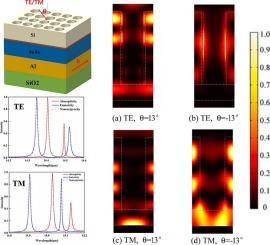基于石墨烯/InAs的圆孔Si在中红外区域13°角非互反热辐射
IF 5.1
3区 材料科学
Q2 MATERIALS SCIENCE, COATINGS & FILMS
引用次数: 0
摘要
随着对非互易热辐射研究的深入,能量转换效率也随之提高。然而,对双极化非互易热辐射的探索仍然不足。本研究介绍了一种利用石墨烯和磁光材料集成的双极化非互易热发射新方法。该结构由反射层(Al)、圆柱形纳米孔(Si)、石墨烯、衬底(SiO2)和InAs组成。结果表明,在中红外区域,当角度为13°,磁场强度为5 T时,可以实现明显的非倒易热发射。阐明了该结构的基本物理性质,分析了磁场强度和入射角对其的影响。最后,利用磁场分布进一步解释了非互反机理。实现了双向极化非倒易发射,对控制和提高非倒易热辐射效率的研究具有一定的价值。本文章由计算机程序翻译,如有差异,请以英文原文为准。

Circular hole Si based on graphene/InAs for nonreciprocal thermal radiation at angle of 13° for mid-infrared region
As research into nonreciprocal thermal radiation progresses, there is a concurrent enhancement in energy conversion efficiency. However, the exploration of dual-polarized nonreciprocal thermal radiation remains insufficient. This study introduces a new method for dual-polarized nonreciprocal thermal emission using integrated graphene and magneto-optical materials. The structure is composed of reflective layer (Al), cylindrical nanopores (Si), graphene, substrate (SiO2) and InAs. Results indicate that significant nonreciprocal thermal emission can be achieved when the angle is 13° and the magnetic field intensity is 5 T for mid-infrared region. The basic physical properties of the structure are clarified, and then the influence of magnetic field intensity and incident angle on it is analyzed. Finally, the magnetic field distribution is used to further explain nonreciprocal mechanism. The bidirectional polarized nonreciprocal emission can be achieved, which has a certain value for the research of controlling and improving the nonreciprocal thermal radiation efficiency.
求助全文
通过发布文献求助,成功后即可免费获取论文全文。
去求助
来源期刊

Diamond and Related Materials
工程技术-材料科学:综合
CiteScore
6.00
自引率
14.60%
发文量
702
审稿时长
2.1 months
期刊介绍:
DRM is a leading international journal that publishes new fundamental and applied research on all forms of diamond, the integration of diamond with other advanced materials and development of technologies exploiting diamond. The synthesis, characterization and processing of single crystal diamond, polycrystalline films, nanodiamond powders and heterostructures with other advanced materials are encouraged topics for technical and review articles. In addition to diamond, the journal publishes manuscripts on the synthesis, characterization and application of other related materials including diamond-like carbons, carbon nanotubes, graphene, and boron and carbon nitrides. Articles are sought on the chemical functionalization of diamond and related materials as well as their use in electrochemistry, energy storage and conversion, chemical and biological sensing, imaging, thermal management, photonic and quantum applications, electron emission and electronic devices.
The International Conference on Diamond and Carbon Materials has evolved into the largest and most well attended forum in the field of diamond, providing a forum to showcase the latest results in the science and technology of diamond and other carbon materials such as carbon nanotubes, graphene, and diamond-like carbon. Run annually in association with Diamond and Related Materials the conference provides junior and established researchers the opportunity to exchange the latest results ranging from fundamental physical and chemical concepts to applied research focusing on the next generation carbon-based devices.
 求助内容:
求助内容: 应助结果提醒方式:
应助结果提醒方式:


